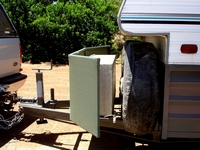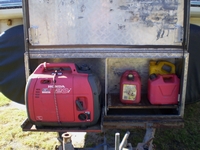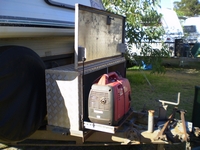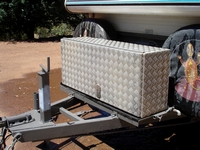Australia So Much to See


Love them or hate them, if you camp outside of caravan parks, you are likely to either need or meet someone using a generator. Most people are considerate users who stick to sociable hours even if in a camp or rest area where there are no specifications. Some will run them well into the night or start up early in the morning. Maybe they are running it just so they can watch television
until midnight or maybe they have a medical need for power most of the night.
Noise: Some brands are noisier than
others. The small Honda and Yamaha petrol inverter generators which most campers choose are fairly quiet and unobtrusive. You can hear them, but if not right next to the generator, it is just a smooth purr. Some of the cheaper generators are not
only noisy, but they have a jerky or annoying rhythm to their sound.
The considerate camper not only uses the generator
only in sensible hours (like between 7 am and 7 pm but even this depends on sun up and down times), but faces the exhaust away
from other campers, if possible on the far side of his caravan. If you do need to use a generator in a group area, asking others
near you first and explaining your need may prevent “camp rage” and even possible vandalism of a noisy machine. Camp as far
away as possible from those not using generators. Some campers use a silencer box to reduce noise, but these are not recommended
by generator distributors as they can cause overheating and damage the generator.
Exhaust fumes from the ULP can also be unpleasant, so facing the exhaust away and preferably down wind of other campers is important. The exhaust also contains carbon monoxide and fatalities have occurred when run in an enclosed area or when fumes have been able to enter the caravan or motorhome. See the danger of Carbon Monoxide poisoning.
You may meet inconsiderate campers who arrive late, park
close to you and start up their noise box. Rather than risk a confrontation turning nasty, it is better to either move away
yourself, or endure it and think tomorrow night we’ll find somewhere really quiet. Ear plugs work well.
See Power
sources for alternatives to using a generator.
A 1 kva generator is adequate for running a camp light, car fridge and
radio, but not for large appliances such as air conditioners, electric fry pans or kettles.
A 2 kva generator
will run most caravan or camper appliances, including caravan air conditioners (with reservations #), and the inverter type may be
needed for sensitive modern electronic equipment. # Brand name generators such as Honda and Yamaha have sufficient power to
start most air conditioners which is the highest draw. Ensure that no other appliances are being used on the generator
when starting an air conditioner. The Honda 2 kva may not handle the load in very hot weather, however for those travelling,
most are choosing to follow milder climates. Some air conditioners will need a larger generator, such as the Yamaha 2.4 kva,
or even a 3 kva. The bigger the generator, the heavier to handle and larger to store.
Ensure the ULP carried is stored
correctly and safely.
You don’t want the smell of petrol in your car or under your bed, so what are the options for carrying a generator and fuel cans?
Best
of all is a built in external slide which some motorhomes and caravans have, but this needs to be incorporated into the design before
manufacture and be build to a standard to ensure no fumes enter the living area if run in situ. If you do this, be certain of
the sized generator you will take. If you designed it to accommodate a present generator then found it was inadequate for your
needs, a larger one would not fit.
Placing on the rear of a motorhome if not part of the original design may result in an illegal rear overhang. South Australian legislation specifies the maximum rear projection as being 60% of the wheelbase (distance between wheels centre to centre), or 3.7 metres from the centre of the rear axle, which ever is the lesser. Your vehicle may come close to this without any additions. Read more here Registration plate must not be obscured. Placing a weight on the back or a caravan when not incorporated into the original design may result in stability problems.
Placing
any addition weight onto the rear of the caravan is unwise due to the effect on the stability of the caravan. Read the links
about caravan stability here, particularly the link to the Youtube video of the Bath University demonstration of load and the effect
on yaw (swinging). Once this effect occurs, a rollover frequently results.
Placing a generator box of the a-frame
may result in an increase of ball weight above the desirable level. These weight and balance issues will be greater in a smaller
or lightweight caravan whereas in a large heavy caravan the weight or a generator will make only a marginal difference.
People
can and do carry them inside their car or motorhome, and we did this when we first purchased ours, however even when running the generator
out of petrol there was still the odour of the fuel in the car when we hit a bumpy road. We had a frame on the caravan
a-frame for jerry cans, but they are obvious to someone wanting to lighten your load (be it with or without your permission).
Like many, we chose to place a box on our a-frame, but our caravan is heavy and stable. We have placed it as close to
the caravan as possible to minimise weight issues. Our box is not designed to run the generator in routinely due in part to
the proximity to the gas bottles behind the box, but it can be run on the slide out, with the front opening lid acting as a ‘roof’
in case of inclement weather.
Some people have the generator housed in a box with weldmesh sides so it is in the open air when run in situ. If you rely on a generator for power and want one with electric start from inside the van, it needs to be run in its storage place.
Safe storage of fuel also needs to be considered.
Can you run the generator in a sound proof box?
Many people do, adding an extraction fan which runs from the generator
(usually 12 volt). Manufacturers however do not recommend boxes as overheating can still occur. For this reason we chose
to only run ours out in the open.
We have seen boxes designed to run in the rear of four wheel drive wagons
and vented to the outside, as well as a-frame boxes, but cannot recommend any of these for the above reason.





Most National Parks do not permit the use of generators, however some do such as Purnululu, Silent Grove and Windjana Gorge
in the
“Permitted in daylight hours
only and with other campers' consent. Small, silenced, portable 1000 watt generators only.”
If you have a genuine medical need
to run a generator, apply to the National Parks Headquarters for that state. Some will grant special exemptions for certain
parks. You will require a Medical Certificate to prove the need.
Many caravanners use a CPAP machine for Sleep Apnoea
using these from an inverter from their 12 volt batteries without need for further supplementation, or have selected one that can
run direct from 12 volt.
To see up to date information of campgrounds within National and State Parks and Reserves
that do and don’t allow generator use see the following links:
Western Australia
List of parks and forest camps where some generators are permitted in prescribed hours.
This includes advice on how to apply for exemptions.
days prior to the activity
for processing). Please contact Permit and Licence Management (PALM) for an application form phone 1300 130 372, email: palm@derm.qld.govor post to PALM Implementation and Support Unit, Department of Environment and Resource
Management GPO
Northern
Territory: Some parks have areas in specified campgrounds which allow the use of generators between the prescribed hours. SeeNT Parks and Reserves Camping for parks which permit use of generators. Note that in the Park Campgrounds within Kakadu
National Park generators are permitted in designated areas during specified hours at Gunlom, Mardugal (Mardukal), and Merl campgrounds.
There is no state wide policy in New South Wales that prohibits generators, however
there may be local restrictions on a park by park basis. For instance if a national park Plan of Management bans generators, they
cannot be used for any purposes including for medical reasons. Plans of Management are legal documents under the National Parks &
Wildlife Act. Plans of Management can be seen at Environment NSW Park Management Plans.
Where the use of generators
is not specifically banned, written consent from a National Parks and Wildlife Services Area Manager is required to use a generator
in a specific park under clause 13 of the National Parks & Wildlife Regulation. This ruling exists because it is considered
that a generator in a quiet environment of a national park would be likely to cause a nuisance.
National Parks and Wildlife
Services would be unlikely to refuse consent for a generator if it was needed for a medical reason. However in this case a medical
certificate must be provided, and additionally such consent would only be valid in parks where generators were not banned either in
a Plan of Management or by sign because consent cannot be issued for activities which are prohibited under the National Parks &
Wildlife Act.
As such anyone intending to use a generator in a New South Wales national park would need to first check with
that park that the use of generators has not been banned in the park’s Plan of Management or by use of a regulation. If generator
use is not banned, the person could then apply in writing to the Area Manager of the park for permission to use the generator.
To
get contact details you can ring 1300 361 967 (press option 2) during business hours.
· Bunyip State Park
· Lake Hindmarsh Reserve
· Murray River Reserves (They must be on a clear patch of ground and have a fire extinguisher or rucksack (container with 20 litres of water) next to the generator)
· Upper Yarra Reservoir Park
· The Gippsland Lakes Coastal Park allow generators if they are not bothering other campers due to the noise level they omit.
There
may be other parks, so make enquiries with the Parks office for that location before finalising your holiday if you need to use a
generator.
Specifically, a person must not play or operate any sound producing device in a park at a volume likely to
(a) cause inconvenience or nuisance to any person; or (b) disturb fauna unless the person does so under and in accordance with
a permit issued by the Secretary (eg if for medical needs). Note that the same inconvenience, nuisance or disturb wildlife prohibition
applies to non sound making activities also.